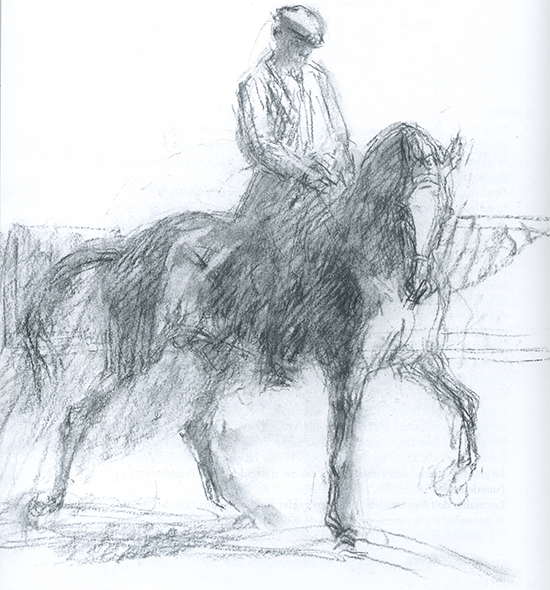
In the second part of our Advanced Dressage with Christopher Bartle series, the British horseman discusses the most useful collecting exercise of all.
As explained in the previous article, collection will be achieved partly by the actions of the rider through position, half-halts and transitions, and partly through the exercises which gradually load the hindquarters and so give rise to the freedom of the forehand. These exercises include the smaller circles and the shoulder-in which has always been considered the most useful collecting exercise of all.
Defining the Movement
As the name implies, the shoulder-in involves the positioning of the horse’s shoulders on the inside track with the horse offering the lateral submission to the inside and bent uniformly around the inside leg. In the classical shoulder-in shown at international level, the degree of bend should be the same as for a six metre circle, or volte. Looking at the horse from above, the pelvis/hips of the horse face forwards along the track so that a line drawn through the point of the hips would be at 90 degrees to the wall, while the horse brings the shoulders off the track to the extent that the horse’s outside foreleg is on the same track as the inside hind leg. This means that the horse will be moving on three tracks.
Of course the horse can still be on three tracks even if only leg-yielding. The important difference between leg yielding and shoulder-in is the bend around the inside leg required in the shoulder-in. This enables the horse to keep the hips facing more or less forwards while the shoulders point at an angle of about 30 degrees off the track. The effect of this positioning is to cause the horse to bring the inside hind leg forward and under the body and therefore slightly closer to the horse’s centre of gravity at the moment of support. On the other hand, in the leg yielding exercise the horse places the inside hind across in front of the outside hind but not so far forward under the body. The leg-yielding, whether done on the diagonal or down the track, has a suppling effect but not a collecting effect.
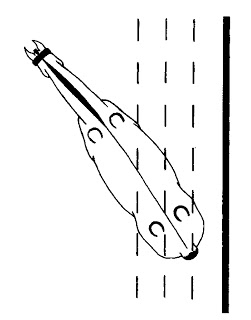
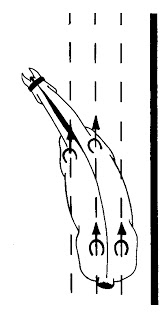
The important difference between leg-yielding and shoulder-in is the bend around the inside leg required in the shoulder-in.
The Rider’s Position
Most of the problems encountered in riding the shoulder-in stem from non-acceptance of the ‘priorities’ explained at length in the earlier series. In turn that often stems from the rider’s failure to position himself correctly in the saddle and the consequent ineffective action of hand and leg. The rider should sit to the inside of the saddle with a feeling of having the outside seatbone close to the centre line of the saddle and receiving most of the rider’s weight The inside seatbone will then be more directly above the stirrup which enables the inside leg to reach well down. Riders frequently make the mistake of leaning over the inside hip rather than sitting to the inside of the saddle. This is often combined with the drawing up of the knee and heel.
However, too much pressure into the heel will tend to push the lower leg away from the horse, so, while the knee and heel should not be drawn upwards, the weight of the leg should be down to the ball of the foot rather than into the heel.
This, of course, is the same position as explained at the beginning of the first series of articles in connection with the turn on the forehand and the leg-yielding exercises. It is in fact the position to be adopted whenever the horse is asked to bend around the inside leg.
If the horse is genuinely submissive to the leg, he will come around the inside leg and take the outside rein. If, in riding the shoulder-in, the horse comes against the inside leg, then the rider must return to the basic priorities explained previously and even if necessary to the turn about the forehand exercise.
The outside leg should be positioned at or just behind the girth to encourage the horse to come around the inside leg as well as to ensure that the horse continues to go forward into the rein. In terms of its lateral effect it will be effective by its presence rather than its action, so if the horse steps away from the inside leg rather than coming around it then he will come against the outside leg. It helps the rider to point the outside foot down the line along which the shoulder-in is being ridden so that if the horse drifts outwards he will come against the outside leg while if he drifts inwards he will come against the inside leg.
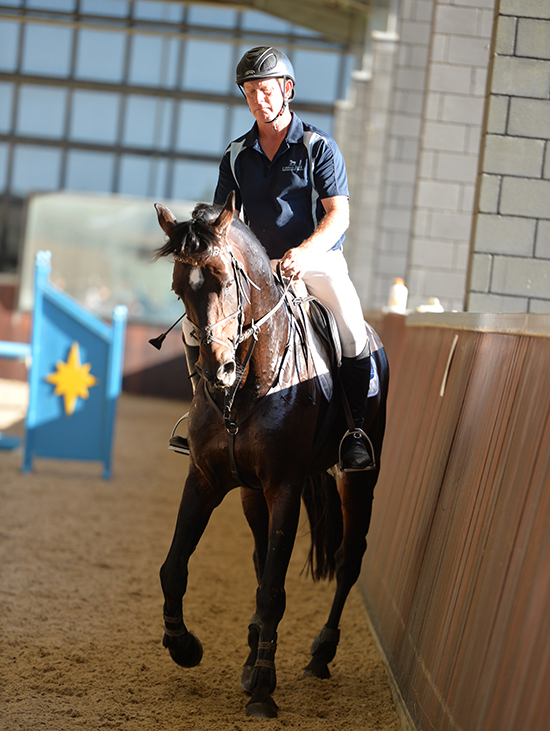
Shoulder in
A frequent error on the part of the rider is to use the inside leg in a backwards fashion and this is often combined with the drawing up of the heel to push the quarters over. At the same time the outside leg comes off the horse and the fence or wall takes over the role. Since the dressage tests tend to ask for the shoulder-in along the track, riders often “get away” with this until they have to ride the exercise on the centre line. For this reason it is always better to ride the shoulder-in away from the wall, for example along the three-quarter or centre line.
A frequent error on the part of the rider is to use the inside leg in a backwards fashion, and this is often combined with the drawing up of the heel to push the quarters over.
The rider should sit to the inside of the saddle with the outside seatbone close to the centre line of the saddle and receiving most of the rider’s weight.
Arm and Hand
The actions of arm and hand must complement rather than contradict the position and effect of the seat and leg. The inside rein must be shortened sufficiently to allow the hand to maintain the lateral flexion without any backward pull on the rein. In general the inside hand should be kept just in front of the outside hand. The axiom of “straight line from elbow through the hand to the horse’s mouth” applies equally to the horizontal plane as to the vertical. In other words the inside hand should not pull across the withers towards the outside hip in order to obtain the bend.
The effect is to block the impulsion and engagement of the inside hind and cause the horse to fall outwards towards the fence or wall. It also tends to cause overbending in the base of the neck.
The outside hand regulates the pace and the bend and applies the half-halts which promote greater collection by extending the moment of support of the inside hind leg. The moment at which the half-halt should be applied is just as the hind foot comes to the ground. In trot this coincides with the outside forefoot which is easier for the rider to recognize.
Initially riders will find it helpful to keep the outside hand beside the withers and to act with a half-halt every time the outside forefoot comes to the ground.
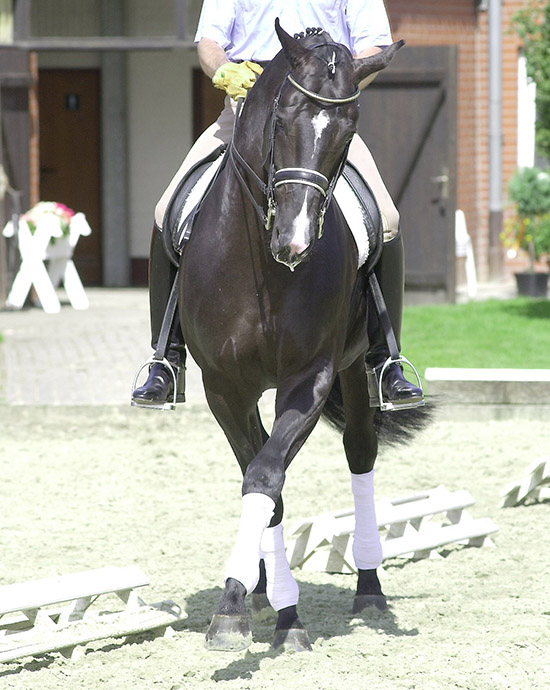
Developing the Shoulder-in
The shoulder-in is developed out of the leg-yielding and the small circles. Once the horse is prepared to offer the lateral submission to the inside through the leg yielding exercise, then the outside leg can begin to play a more important role in encouraging the horse to offer more bend around the inside leg and also to bring the horse in on the circle and into the shoulder-in.
A small circle and then in due course a well-ridden comer will set the horse up for the shoulder-in as if he were going to come on to a small circle. Just as the shoulders start to leave the track, the outside hand opposes the forward movement while the inside leg applies pressure at the girth to indicate to the horse to move laterally along the line of the shoulder-in. Once the shoulder-in has started, the emphasis changes from the pressure of the inside leg, asking the horse to step away, to the outside leg, riding the horse into the outside rein. The inside leg remains effective by its presence in maintaining the bend and thereby the engagement of the inside hind.
Trouble-shooting
The most common faults in the shoulder-in include insufficient bend around the inside leg, so that the shoulder-in appears to be at too shallow an angle to the track. This can be accompanied by excessive bend at the base of the neck and is caused by lack of submission to the inside leg and thus the rider’s use of the inside rein against the neck to obtain the bend. Another fault is excessive angle, again with insufficient bend. This often comes about through the backward pressure of the inside leg pushing the quarters across.
These problems are usually caused by the incorrect application of the aids on the part of the rider and are more easily resolved. Head tilting or resistance to lateral flexion at the poll are more difficult problems to resolve. In fact they originate from the defensive reactions or the resistance to the lateral submission in the earlier work. Over-use of the inside rein to obtain the bend will often cause the horse to tilt the nose outwards and the ears inwards. The temptation for the rider is to use the inside rein to correct the tilting; however, it tends to have the reverse effect.
The real solution lies in persuading the horse to take the outside rein. In due course the experienced rider will be able to improve the lateral flexion at the poll to the inside by applying the half-halts slightly away from the neck. This will encourage the horse to take the rein after the half-halt and become light on the inside rein as he offers the lateral flexion.
The important point to remember throughout is that the emphasis is on the horse bringing the body towards the inside leg, even though in terms of the direction of the movement the horse is seen to be moving away from the bend.
This is why the shoulder-in is related to the pirouette and the half-pass, even though in the schooling the logical progression is from the turn about the forehand, through the leg-yield, to the shoulder-in, and then to the pirouette and half-pass. The pirouette and half-pass will be the subject of the next article.
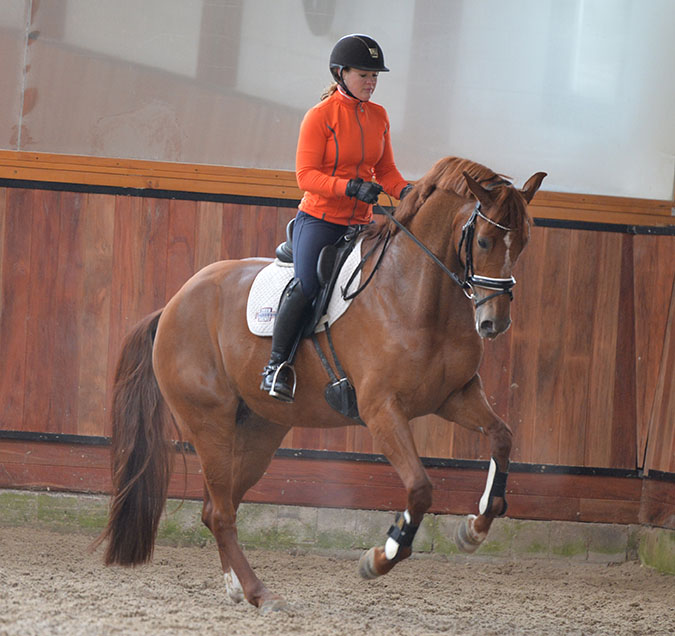
The best European based stallions are available from IHB – stallions Vivaldi, and his sons. Plus lots of new stallions – go to www.ihb.com.au for more information www.ihb.acom.au, or ring Glenis on 03 5439 7251
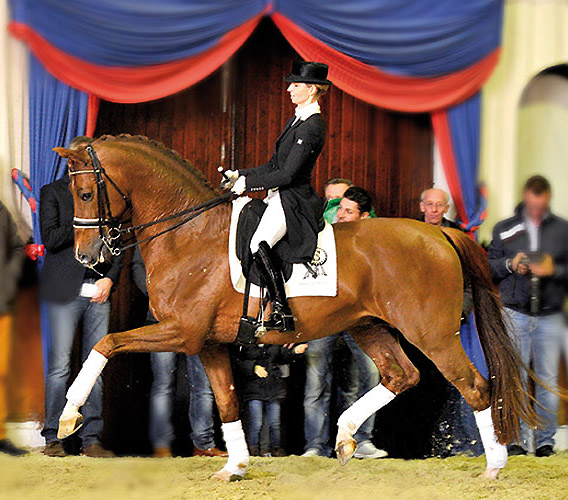
Vivaldi
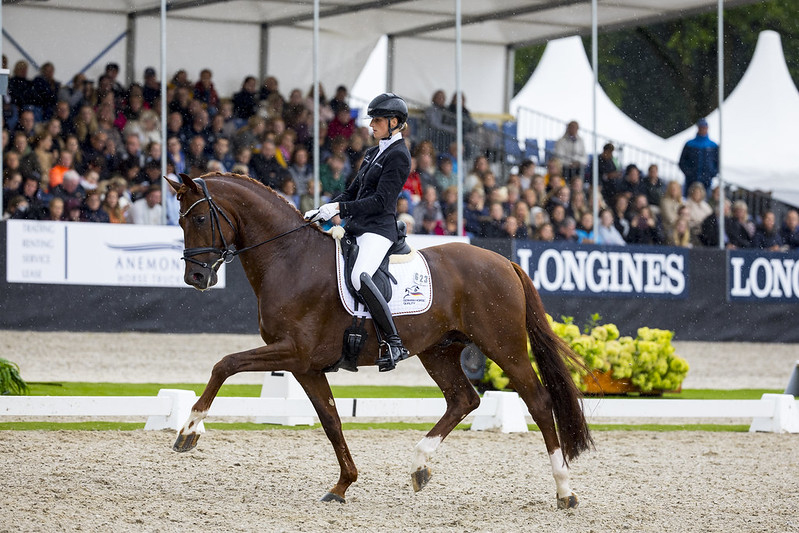
Vitalis
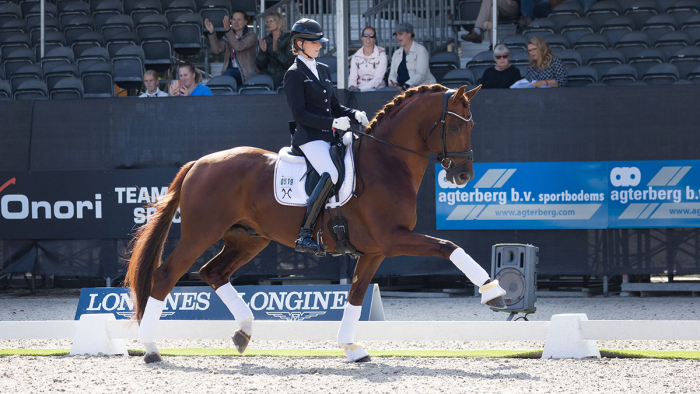
Vitalos
Interested in Dressage? We have articles with all the world’s top trainers just one click away: http://www.horsemagazine.com/thm/article/dressage/



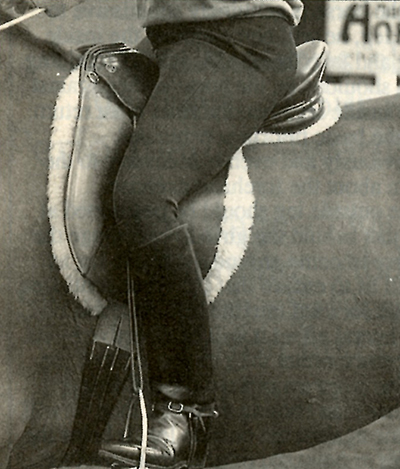

Excellent – thank you! Where can Part 1 and Part 3 be found?
Here is the link to part one http://www.horsemagazine.com/thm/2017/02/introducing-collection-with-christopher-bartle-part-one/ and part three should be up some time next week, glad you liked it – CH